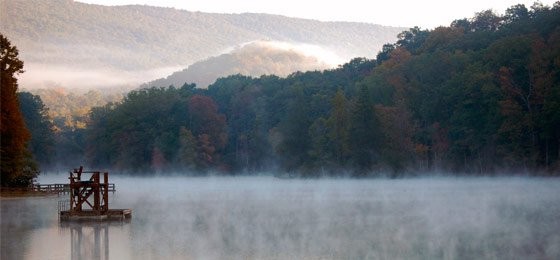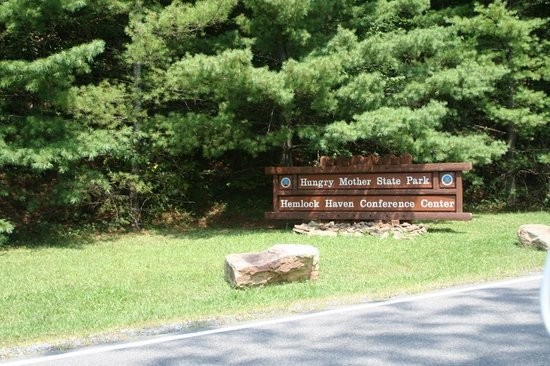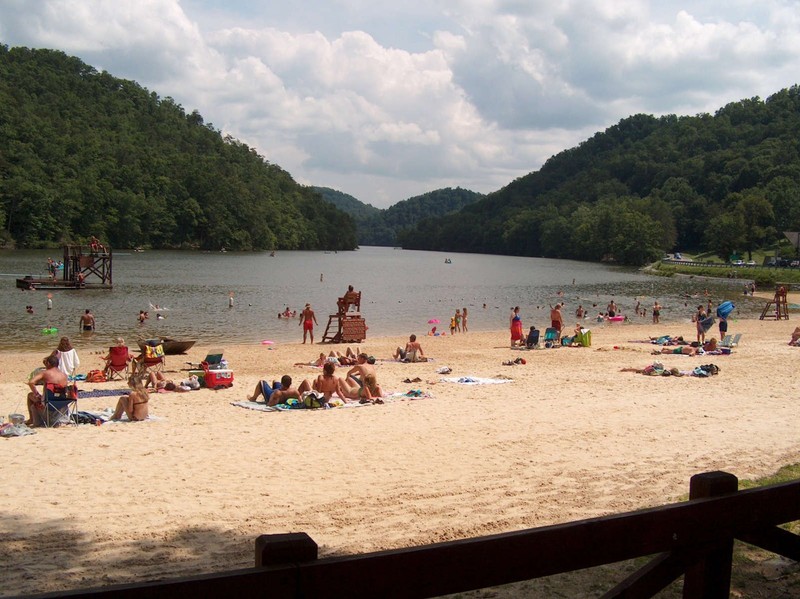Hungry Mother State Park
Introduction
Text-to-speech Audio
Images
Hungry Mother Lake

Hungry Mother State Park roadside entrance sign

Hungry Mother Lake and beach

Backstory and Context
Text-to-speech Audio
Virginia witnessed the creation of its first national park when the Shenandoah National Park opened to visitors in 1924. Shenandoah became so successful and welcomed so many visitors that Virginia passed legislation for the creation of its own state park system two years later. The legislation allowed for the creation of the Virginia State Commission on Conservation and Development to oversee the development of the state park system. William E. Carson served as the commission’s first chairman. Carson proposed that the first state park to be located on Virginia’s coast to honor Virginia’s diverse geology and serve as a companion to the Shenandoah National Park. In 1930, the commission hired the British landscape architect Bob E. Burson to assist in the development of the Virginia State Parks system.
After conducting tedious research and many site visits over a period of two years, in 1932 Burson proposed the creation of six parks to serve as the core of the fledgling Virginia State Parks system. Each of the six parks would represent the four largest regions of the state: Seashore State Park (now known as First Landing) and Westmoreland State Park in the Tidewater region, Staunton River State Park and Fairy Stone State Park in the Piedmont region, Hungry Mother State Park in the Valley of Virginia, and Douthat State Park in the Mountain and Valley Region. With the help of Burson, the Commission realized that the state park system should promote tourism in Virginia in addition to providing recreational opportunities for residents.
As part of President Franklin D. Roosevelt’s New Deal program during the Great Depression, funding and labor opportunities for public infrastructure became available to state governments. With guidance from the National Park Service, many states, including Virginia, took advantage of this opportunity and began construction on their own state parks. In Southwest Virginia, plans to create a state park were already in motion. In June 1930, a privately-owned recreation facility called Lake Forest opened on the current site of Hungry Mother State Park. It contained a dance pavilion, swimming pool, concession stand, restaurant, picnic area, and a small lake from the dammed up Hungry Mother Creek. Local landowner John D. Lincoln acquired the 2,500 acres of land on Hungry Mother Creek two years later in September, and formally deeded the property to the state of Virginia on October 13, 1933.
Up until the state taking legal possession of the property on Hungry Mother Creek, the name of the park was intended to remain Lake Forest. However, when the Commission on Conservation and Development publicly released the names of the six proposed state parks on October 16, Hungry Mother was listed instead of Lake Forest. The reason behind the change is unknown, but it likely involved the local legend around the name for Hungry Mother Creek. While there are several versions of the legend, the common theme that runs throughout all stories is that prior to permanent European settlement of the area a little boy was found wandering around the creek saying “Hungry, Mama.” Some stories explain how the child was found next to the body of his dead mother, while others explain how the boy wandered off from his homestead alone. The commonly accepted version describes a Shawnee Indian attack on a nearby settlement where a mother and child were carried off. The two captives eventually escaped and began walking back to their settlement, eating only foraged berries. The mother finally collapses from poison or hunger, and the child wanders down a creek until he is found, saying only “Hungry, Mama.” A search party set out to locate the woman, and found her dead at the foot of the mountain. Since then, the creek has been known as Hungry Mother Creek. It is likely that the Commission changed the name of the park to incorporate the local lore thereby attracting visitors.
Construction began on Hungry Mother State Park on October 15, 1933 when Civilian Conservation Corps (CCC) companies 1252, 1249, and 1259 arrived on site. The CCC worked tirelessly to dismantle the existing structures on the property before erecting a dam to create the 108-acre Hungry Mother Lake. When the park officially opened on June 13, 1936, the CCC completed construction on seven cabins, the Custodian’s House, beach area, concession stand, bath houses, and a picnic area. It took the CCC another five years to complete six more cabins, the campground, a restaurant, the trail system, and other necessary infrastructure. The cabins at Hungry Mother State Park were the first in the state and the first state park in the nation to be fitted with electricity. In order to get electricity, cabin guests inserted a coin into a meter and received electricity into their cabin for a period of time. Hungry Mother also became the first park in Virginia to offer a sandy beach area for the lake, John D. Lincoln personally shipped a train car full of Virginia Beach sand for that purpose. During its first year of operation, Hungry Mother State Park welcomed 58,482 visitors, more than half of attendance of all the state parks combined. Throughout the duration of the twentieth-century, the Hungry Mother accumulated more land and facilities, which expanded the park to 3,334 acres.
Today, Hungry Mother State Park continues to be a quiet mountain retreat for Southwest Virginia. The park offers a wide variety of activities including hiking, swimming, canoeing, kayaking, camping, fishing, biking, and a restaurant, with many of the original CCC-erected structures remain in use. Hungry Mother State Park was added to the Virginia Landmarks Register in June, 2006 and to the National Register of Historic Places in April 2007.
Sources
Hungry Mother State Park. Virginia State Parks. September 12, 2018. http://www.dcr.Virginia.gov/state-parks/hungry-mother#general_information.
Hungry Mother State Park Camping and Cabins. Virginia is for Lovers. March 15, 2016. September 12, 2018. https://www.Virginia.org/listings/PlacesToStay/HungryMotherStateParkCampingandCabins/.
